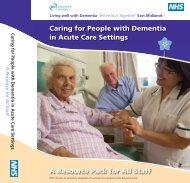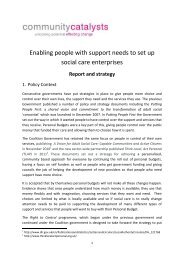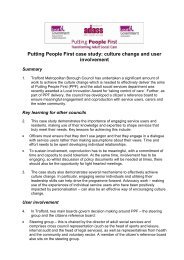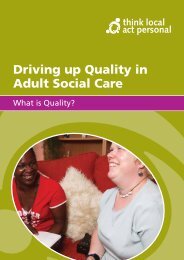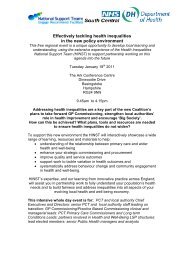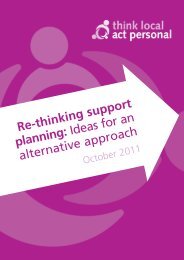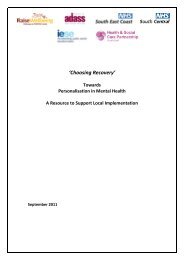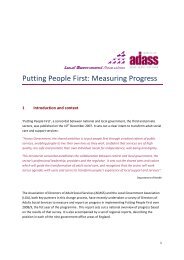Practical approaches to safeguarding and personalisation (pdf ...
Practical approaches to safeguarding and personalisation (pdf ...
Practical approaches to safeguarding and personalisation (pdf ...
Create successful ePaper yourself
Turn your PDF publications into a flip-book with our unique Google optimized e-Paper software.
<strong>Practical</strong> <strong>approaches</strong> <strong>to</strong> <strong>safeguarding</strong> <strong>and</strong> <strong>personalisation</strong><br />
Introduction<br />
This briefing paper sets out how <strong>personalisation</strong> of support <strong>and</strong> more effective <strong>safeguarding</strong><br />
can be mutually supportive. It shows how self-directed support can help <strong>to</strong> prevent or reduce<br />
the risk of harm <strong>and</strong> abuse. It is not, primarily, about how councils <strong>and</strong> partner organisations<br />
should respond <strong>to</strong> abuse. Personalisation does not replace the need for adult <strong>safeguarding</strong><br />
systems <strong>and</strong> procedures.<br />
Strengthening citizenship <strong>and</strong> communities in line with the <strong>personalisation</strong> agenda can<br />
contribute <strong>to</strong> keeping people safer. Self-directed support enables people <strong>to</strong> have choice <strong>and</strong><br />
control over their lives, <strong>and</strong> be active citizens rather than passive recipients of services.<br />
People who have choice <strong>and</strong> control over their support arrangements, keep in <strong>to</strong>uch with<br />
family <strong>and</strong> friends, <strong>and</strong> stay active <strong>and</strong> healthy, are likely <strong>to</strong> be at less risk of abuse than those<br />
who are isolated <strong>and</strong> dependent on services. They are also more likely <strong>to</strong> have people in their<br />
lives that would notice <strong>and</strong> take action in response <strong>to</strong> any concerns of abuse.<br />
Self-directed support provides a framework for managing risk. By incorporating critical<br />
checks <strong>and</strong> balances in<strong>to</strong> person-centred <strong>approaches</strong>, the management of risks <strong>and</strong> the<br />
maximisation of benefits arising from taking considered risk can be improved.<br />
An exploration of the evidence base concerning risk enablement in the self-directed support<br />
process has been produced by the Social Care Institute for Excellence (SCIE) 1 . The SCIE<br />
report identifies that misunderst<strong>and</strong>ings about personal budgets have sometimes led <strong>to</strong> the<br />
misconception that people will be left unsupported, taking full responsibility for managing<br />
risk alone. It also identifies that misunderst<strong>and</strong>ings about the principles <strong>and</strong> practice of<br />
independent living can impact upon common conceptions of <strong>personalisation</strong> being ‘risky’.<br />
Risk aversion <strong>and</strong> generalised assumptions about groups of people can lead <strong>to</strong> professionals<br />
denying opportunities <strong>to</strong> people <strong>and</strong> restricting their lives. Emerging evidence does not appear<br />
<strong>to</strong> support concerns about increased risk through personalised services. A Skills for Care<br />
survey 2 shows that despite fears that a move <strong>to</strong>wards person-centred care may leave<br />
individuals more vulnerable, people moving <strong>to</strong> direct payments <strong>and</strong> employing their own<br />
personal assistants experienced significantly less abuse than those recieving traditional<br />
council-commissioned services.<br />
This briefing attempts <strong>to</strong> dispel myths <strong>and</strong> focus on practical <strong>and</strong> positive ways in which<br />
councils are integrating <strong>safeguarding</strong> <strong>and</strong> <strong>personalisation</strong>, particularly in relation <strong>to</strong> selfdirected<br />
support <strong>and</strong> personal budgets, as they redesign their care management process around<br />
the principles of <strong>personalisation</strong>.<br />
The principal objectives of this briefing paper are:<br />
• <strong>to</strong> improve underst<strong>and</strong>ing of <strong>safeguarding</strong> <strong>and</strong> risk management as an integral part of<br />
<strong>personalisation</strong><br />
1 Carr, S (2010) SCIE Report 36: Enabling risk, ensuring safety: Self-directed support <strong>and</strong> personal budgets<br />
London: SCIE<br />
2 Employment Aspects <strong>and</strong> workforce implications of direct payment. IFF research. Skills for Care 2008<br />
7



